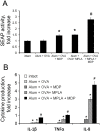Powerful Complex Immunoadjuvant Based on Synergistic Effect of Combined TLR4 and NOD2 Activation Significantly Enhances Magnitude of Humoral and Cellular Adaptive Immune Responses
- PMID: 27187797
- PMCID: PMC4871337
- DOI: 10.1371/journal.pone.0155650
Powerful Complex Immunoadjuvant Based on Synergistic Effect of Combined TLR4 and NOD2 Activation Significantly Enhances Magnitude of Humoral and Cellular Adaptive Immune Responses
Abstract
Binding of pattern recognition receptors (PRRs) by pathogen-associated molecular patterns (PAMPs) activates innate immune responses and contributes to development of adaptive immunity. Simultaneous stimulation of different types of PRRs can have synergistic immunostimulatory effects resulting in enhanced production of molecules that mediate innate immunity such as inflammatory cytokines, antimicrobial peptides, etc. Here, we evaluated the impact of combined stimulation of PRRs from different families on adaptive immunity by generating alum-based vaccine formulations with ovalbumin as a model antigen and the Toll-like receptor 4 (TLR4) agonist MPLA and the Nucleotide-binding oligomerization domain-containing protein 2 (NOD2) agonist MDP adsorbed individually or together on the alum-ovalbumin particles. Multiple in vitro and in vivo readouts of immune system activation all showed that while individual PRR agonists increased the immunogenicity of vaccines compared to alum alone, the combination of both PRR agonists was significantly more effective. Combined stimulation of TLR4 and NOD2 results in a stronger and broader transcriptional response in THP-1 cells compared to individual PRR stimulation. Immunostimulatory composition containing both PRR agonists (MPLA and MDP) in the context of the alum-based ovalbumin vaccine also enhanced uptake of vaccine particles by bone marrow derived dendritic cells (BMDCs) and promoted maturation (up-regulation of expression of CD80, CD86, MHCII) and activation (production of cytokines) of BMDCs. Finally, immunization of mice with vaccine particles containing both PRR agonists resulted in enhanced cellular immunity as indicated by increased proliferation and activation (IFN-γ production) of splenic CD4+ and CD8+ T cells following in vitro restimulation with ovalbumin and enhanced humoral immunity as indicated by higher titers of ovalbumin-specific IgG antibodies. These results indicate that combined stimulation of TLR4 and NOD2 receptors dramatically enhances activation of both the humoral and cellular branches of adaptive immunity and suggests that inclusion of agonists of these receptors in standard alum-based adjuvants could be used to improve the effectiveness of vaccination.
Conflict of interest statement
Figures






Similar articles
-
Synergistic effect of Nod1 and Nod2 agonists with toll-like receptor agonists on human dendritic cells to generate interleukin-12 and T helper type 1 cells.Infect Immun. 2005 Dec;73(12):7967-76. doi: 10.1128/IAI.73.12.7967-7976.2005. Infect Immun. 2005. PMID: 16299289 Free PMC article.
-
New chimeric TLR7/NOD2 agonist is a potent adjuvant to induce mucosal immune responses.EBioMedicine. 2020 Aug;58:102922. doi: 10.1016/j.ebiom.2020.102922. Epub 2020 Jul 30. EBioMedicine. 2020. PMID: 32739871 Free PMC article.
-
Acetalated Dextran Microparticles for Codelivery of STING and TLR7/8 Agonists.Mol Pharm. 2018 Nov 5;15(11):4933-4946. doi: 10.1021/acs.molpharmaceut.8b00579. Epub 2018 Oct 15. Mol Pharm. 2018. PMID: 30281314 Free PMC article.
-
Targeting Pattern Recognition Receptors (PRR) for Vaccine Adjuvantation: From Synthetic PRR Agonists to the Potential of Defective Interfering Particles of Viruses.Viruses. 2017 Jul 13;9(7):186. doi: 10.3390/v9070186. Viruses. 2017. PMID: 28703784 Free PMC article. Review.
-
Unleashing the potential of NOD- and Toll-like agonists as vaccine adjuvants.Proc Natl Acad Sci U S A. 2014 Aug 26;111(34):12294-9. doi: 10.1073/pnas.1400478111. Epub 2014 Aug 18. Proc Natl Acad Sci U S A. 2014. PMID: 25136133 Free PMC article. Review.
Cited by
-
THP-1 Cells and Pro-inflammatory Cytokine Production: An in Vitro Tool for Functional Characterization of NOD1/NOD2 Antagonists.Int J Mol Sci. 2019 Aug 30;20(17):4265. doi: 10.3390/ijms20174265. Int J Mol Sci. 2019. PMID: 31480368 Free PMC article.
-
Synthesis and Immunological Evaluation of Mannosylated Desmuramyl Dipeptides Modified by Lipophilic Triazole Substituents.Int J Mol Sci. 2022 Aug 3;23(15):8628. doi: 10.3390/ijms23158628. Int J Mol Sci. 2022. PMID: 35955759 Free PMC article.
-
Safety and immunogenicity of GamEvac-Combi, a heterologous VSV- and Ad5-vectored Ebola vaccine: An open phase I/II trial in healthy adults in Russia.Hum Vaccin Immunother. 2017 Mar 4;13(3):613-620. doi: 10.1080/21645515.2016.1238535. Epub 2017 Feb 2. Hum Vaccin Immunother. 2017. PMID: 28152326 Free PMC article. Clinical Trial.
-
Als3-Th-cell-epitopes plus the novel combined adjuvants of CpG, MDP, and FIA synergistically enhanced the immune response of recombinant TRAP derived from Staphylococcus aureus in mice.Immun Inflamm Dis. 2021 Sep;9(3):971-983. doi: 10.1002/iid3.456. Epub 2021 May 19. Immun Inflamm Dis. 2021. PMID: 34010502 Free PMC article.
-
Human Breast-Milk Feeding Enhances the Humoral and Cell-Mediated Immune Response in Neonatal Piglets.J Nutr. 2018 Nov 1;148(11):1860-1870. doi: 10.1093/jn/nxy170. J Nutr. 2018. PMID: 30247686 Free PMC article.
References
-
- Brewer JM, Conacher M, Hunter CA, Mohrs M, Brombacher F, Alexander J. Aluminium hydroxide adjuvant initiates strong antigen-specific Th2 responses in the absence of IL-4- or IL-13-mediated signaling. J Immunol. 1999. December 15;163(12):6448–54. - PubMed
-
- Seder RA, Paul WE. Acquisition of lymphokine-producing phenotype by CD4+ T cells. Annu Rev Immunol. 1994;12:635–73. - PubMed
Publication types
MeSH terms
Substances
LinkOut - more resources
Full Text Sources
Other Literature Sources
Molecular Biology Databases
Research Materials

